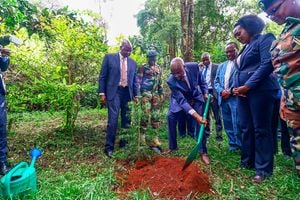Eye on the sky: Kenyan race to space intensifies

Daniel Chu Owen setting up the telescope on top of a building in Nairobi. PHOTO | COURTESY
The telescope is assembled, ready for nightfall and a star party. When dusk creeps in, Daniel Chu Owen carries it to the top of the building and pitches it.
“If you looked at the London sky using a telescope, you wouldn’t be lucky to see any stars,” Mr Chu Owen remarks after setting up the gadget, “You (here in Nairobi) should count yourselves lucky!” Mr Chu Owen co-founded the Travelling Telescope with his wife and astronomer Susan Murabana, to promote astronomy to school children.
More than 300 kilometres away, on Lake Victoria, no fisherman ventures out without understanding the galaxy. Although they own no telescopes, the fishermen rely on stars to get their bearing and direction while sailing on the huge mass of water.
“When the moon is first sighted, we know that the fish will be in deeper water. As it blooms into a full moon, they move to shallower water,” says Willis Omulo, an environmentalist and fisherman in Homa Bay.
Observing the skies is crucial to understanding the undercurrents in the lake, which helps the fishermen know where the fish are migrating to.
Now, scientists are pushing for the setting up of an astronomical observatory, equipped with powerful telescopes to help observe the planets and stars, and use the insights from images more powerful than the eye can see, to make sense of the universe and in turn make life on earth better.
Scientists meeting in Nairobi under the auspices of the Kenya Optical Telescope Initiative (KOTI), two weeks ago, are keen to have the observatory up and running in five or so years. At their conference, they reiterated the reasons why Kenya is best placed to host an observatory: Firstly, the conditions are perfect.
“The ideal location is a place with clear skies most of the year; very little cloud cover; little moisture in the air and minimal wind. Such a location can give very sharp images,” said Martyn Wells of the United Kingdom Astronomy Technology Centre.
Secondly, Kenya straddles the equator, which affords it a unique vantage point, from where scientists can view both the northern and southern hemisphere. Moreover, there are few other telescopes on the longitudinal area that Kenya occupies. If an observatory were set up and it operated in tandem with observatories in India and the Canary Islands, it would be like paradise for researchers, monitoring astronomical activities as the earth rotates.
“Kenya hosts some of the best sites for astronomical research in Africa and they are comparable to some of the best sites in the world, due to its location on the equator and dark skies. Kenya has fantastic skies which can be used as a resource. It occupies a unique geographical area, yet it has no existing observatory,” said Richard Vaughn, coordinator of KOTI’s working party, during the meeting.
PROJECT
The idea to build an optical telescope, which is really the gist of an astronomical observatory, was hatched a few years ago, when the initiative to build the world’s largest radio telescope – the Square Kilometre Array (SKA) – came up.
“The SKA project was an open international bid. South Africa decided to partner with eight other African countries (including Kenya) to bid for the project, and they won,” recalls Head of Physics and Space Science at the Technical University of Kenya Paul Baki.
The project is co-hosted by South Africa and Australia, with the core of the project in South Africa. Other portions of the project are spread in Kenya, Ghana, Mozambique, Mauritius, Botswana, Namibia and Zambia.
Now a group of scientists – Prof Paul Baki of the Technical University of Kenya, Dr Hashim Nadir of Kenyatta University, Dr Bitange Ndemo of University of Nairobi – and Richard Vaughn of INCA, are pushing for the setting up of an astronomical observatory in Kenya.
Already, the scientists funded by Kenya’s National Commission for Science, Technology and Innovation (NACOSTI) in collaboration with the National Research Foundation (NRF) of South Africa, have identified and shortlisted three sites to set up the telescope – Mt Kulal and Ol Donyo Nyiro on the southern shore of Lake Turkana; and Ololokwe, south of Samburu. However, logistical challenges are edging out Mt Kulal.
The sites were picked from a selection of six, after analysis of satellite data showed they have potential to hold world-class observatories. From these sites, astronomers can view more than 85 per cent of the sky in both the northern and southern celestial hemispheres.
“These sites are far from urban and industrial development, so there is very little pollution of the sky (by light or effluent). At the best sites, the local microclimate allows for clear skies most of the year,” explains Mr Vaughn.
If set up in Turkana, the observatory would be just a modern (and more advanced) version of something the locals have been doing for ages – reading the stars.
Residents have a way of telling whether there will be adequate rainfall in a particular year, just by looking at the part of the eastern sphere from which the sun is rising. They place three stones in various directions to help them monitor the direction of sunrise, and then use their traditional observatory skills for navigation (to give directions) or to predict seasons and climate. The stars are an incredible source of information, used for various purposes across cultures. Their patterns indicate when farmers can prepare their farms and when the time is right for sowing. Their movement signalling that the seasons are changing. But while Africans read the galaxy with their naked eyes, modern scientists read it with optical telescopes to reveal unseen knowledge that is key to all sectors. Thus traditional knowledge of astronomy could go high-tech, providing more advanced data for application in agriculture, medicine and even tourism (South Africa and the United States have turned their observatory sites into significant tourist attractions).
“Space is the most valuable asset today because from space, we are able to know how many acres of maize there are in the country,” says Dr Bitange Ndemo, former ICT principal secretary and a member of the Kenya Optical Telescope Initiative (KOTI). He adds that from space, Kenya can get data to analyse and predict key indicators like food sufficiency and climate change.
“In astronomy, we use lenses to look at things which are far away from earth. The same technology can be used for medical imaging, to look for illnesses like cancer in the body, thanks to better and sharper images of body cells. Astronomy is also used in data processing, in the stock market, in land surveying, military spying and of course, space science,” adds Head of Physics and Space Science at the Technical University of Kenya Paul Baki.
TRAINING
Three Kenyan universities namely University of Nairobi, Technical University of Kenya and Kenyatta University are already offering courses in astronomy and space science, a move Dr Wells of the UK Astronomy Technology Centre applauds, because building an observatory needs locals with skills in science, technology, engineering and mathematics, to build the dome, telescope and the fibre optics.
Unfortunately, without an astronomical observatory, local training has remained largely theoretical. With the setting up of an observatory with radio and optical telescopes, that could change, though there are no concrete timelines.
Prof Baki adds that the telescope would boost technology development, especially in optical engineering, research and training, control brain drain and attract youth to science and boost international cooperation. For these and other benefits, scientists are leveraging Kenya’s clear skies and minimal humidity. The only hurdle, says Prof Baki, is that there is need for investment from government.
“What remains to be done is to install ground-based instrumentation (weather stations) at the sites to establish the one which is most suitable,” says Prof Baki. The installation of the instruments is being funded by the UK through the Global Challenges Research Fund. The establishment of the ground instruments is set to be complete by the end of March, when that particular funding ends.
“We need Kenyan government’s involvement in the form of official endorsement and funding for the smaller outreach telescopes while data is being gathered, as well as support for the continuing operation of the local working party. At the same time, we shall be seeking international funding for the construction of the main telescope itself.”
However, the telescope is expected to be up in two years (2021), subject to availability of funding, and fully operational after five years, according to David Buckley, a senior astronomer from the South African Astronomical Observatory, and a member of KOTI. The telescope (1.4 metres in diameter) would cost between Sh150.7 million and Sh402 million, and Dr Buckley notes that it would be more economical to buy the telescope, rather than have it constructed in the country.
Lack of optical engineers in the country is also an obstacle. There are degree courses in astronomy and astrophysics in the University of Nairobi and master’s and PhD courses in Kenyatta University, Technical University of Kenya and University and an outreach programme, the Travelling Telescope.
South Africa offers scholarships to astronomy and engineering students from Kenya to pursue master’s and PhD course, but Prof Baki notes that without a concrete place to practice their skills and further research, a good number of them do not return. Currently, 16 Kenyans are being trained through the Square Kilometre Array sponsorship programme in South African universities and at the University of Leeds in the UK.
If set up, the telescope would be the only research-class observatory in equatorial Africa.




